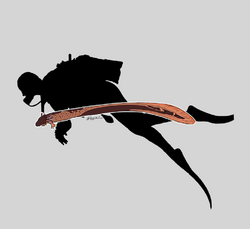Biology:Habrosaurus
| Habrosaurus | |
|---|---|

| |
| Illustration of Habrosaurus dilatus specimen UALVP 43910 | |
| Scientific classification | |
| Domain: | Eukaryota |
| Kingdom: | Animalia |
| Phylum: | Chordata |
| Class: | Amphibia |
| Order: | Urodela |
| Family: | Sirenidae |
| Genus: | †Habrosaurus Gilmore, 1933 |
| Type species | |
| †Habrosaurus dilatus Gilmore, 1933
| |
| Other species | |
| |
| Synonyms | |
|
Adelphesiren[1] | |
Habrosaurus (IPA: [hæbroʊsʊrʌs], meaning "graceful lizard") is an extinct genus of prehistoric salamanders, and the oldest known member of the family Sirenidae. Two species are known, H. prodilatus from the middle Campanian Dinosaur Park Formation of Alberta,[1] and H. dilatus from the late Maastrichtian and Paleocene of western North America. It is relatively common in the Lance Formation of Wyoming, and less common in the Hell Creek Formation of Montana.
Description
Habrosaurus was a gigantic sirenid,[2] its length is estimated to be around 1.6 m (5 ft 3 in), estimated from its trunk vertebrae length (up to 2 cm long).[3] H. prodilatus possessed chisel-like teeth, while H. dilatus had bulkier crowns. The teeth of H. dilatus also exhibited heavy wear facets while those of H. prodilatus had only mild wear, suggesting that H. dilatus was more adapted for durophagy than H. prodilatus. H. dilatus may have preyed upon arthropods with hard carapaces as well as mollusks.[1]
Classification
Habrosaurus is a sister taxa to both Pseudobranchus and Siren[1] which are the only genera in the family Sirenidae. Sirenids are classified by their neotenous traits (complete lack of hindlimbs and external gills in both larval and adult states).
References
- ↑ 1.0 1.1 1.2 1.3 Gardner, James D. (November 2003). "Revision of Habrosaurus Gilmore (Caudata; Sirenidae) and relationships among sirenid salamanders". Palaeontology 46 (6): 1089–1122. doi:10.1046/j.0031-0239.2003.00335.x.
- ↑ Bonett, R. M., Trujano-Alvarez, A. L., Williams, M. J. & Timpe, E. K. 2013. Biogeography and body size shuffling of aquatic salamander communities on a shifting refuge. Proceedings of the Royal Society B 280, 20130200.
- ↑ Wilson, Gregory P.; Clemens, William A.; Horner, John R.; Hartman, Joseph H. (2014-01-21) (in en). Through the End of the Cretaceous in the Type Locality of the Hell Creek Formation in Montana and Adjacent Areas. Geological Society of America. ISBN 978-0-8137-2503-1.
Wikidata ☰ Q5636962 entry
 |



